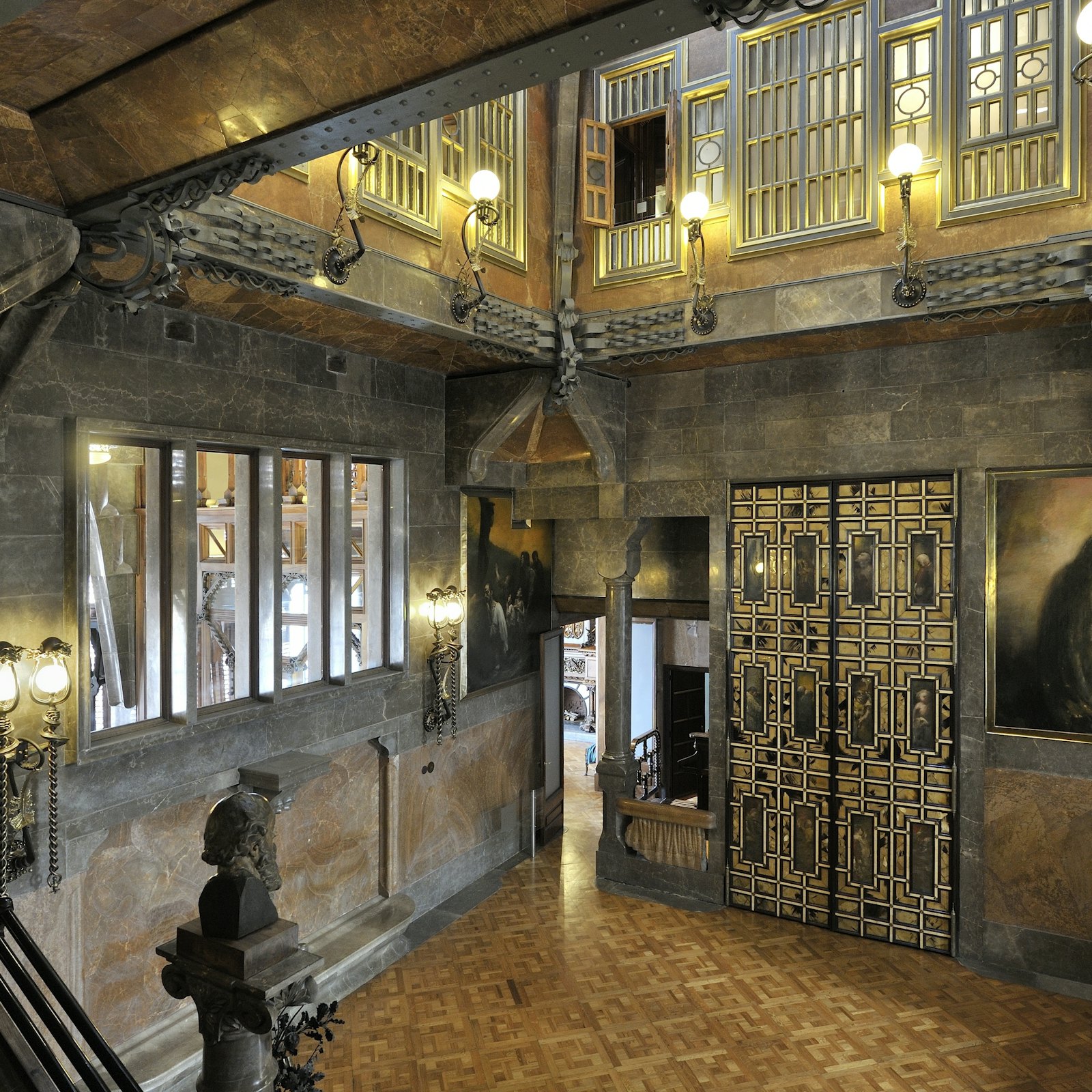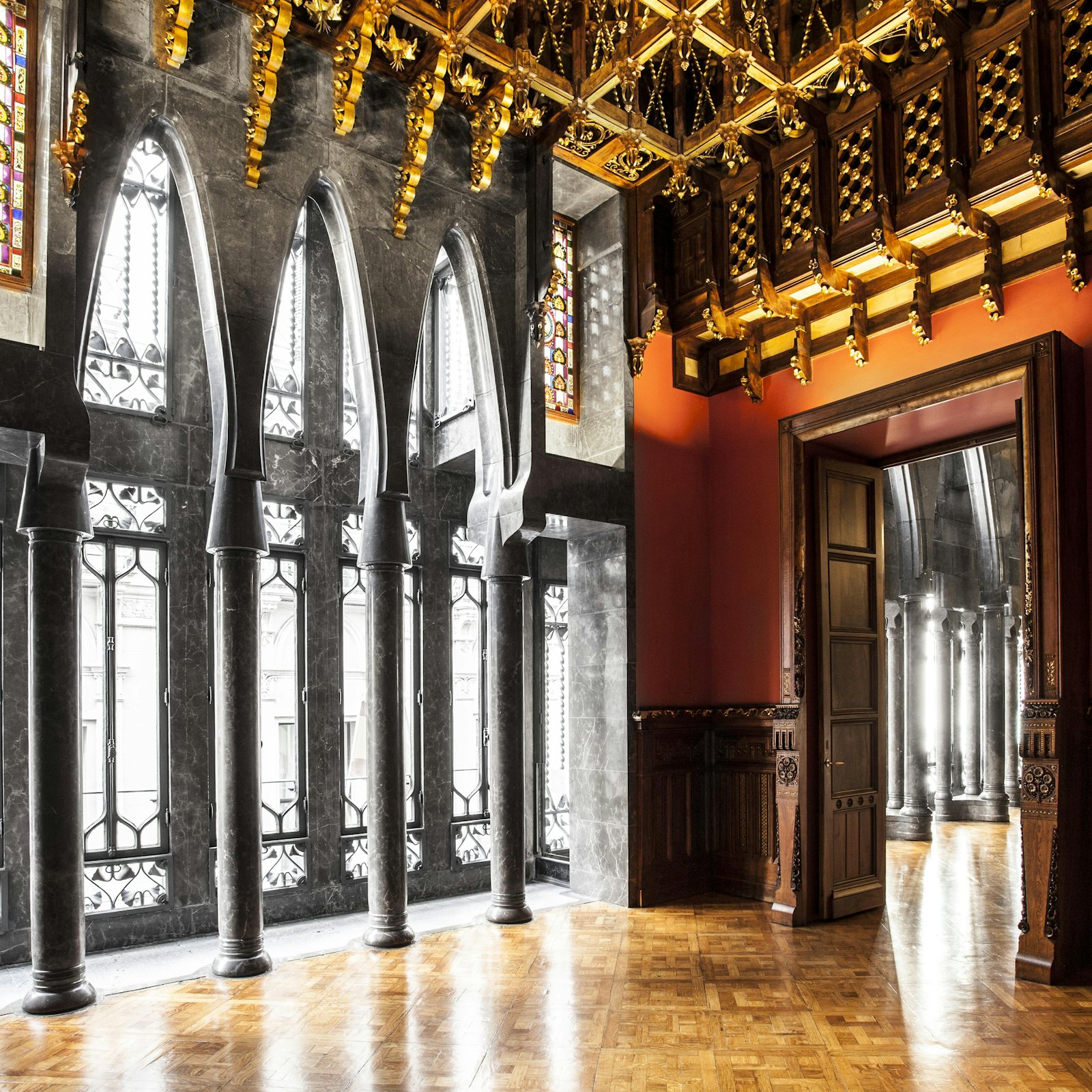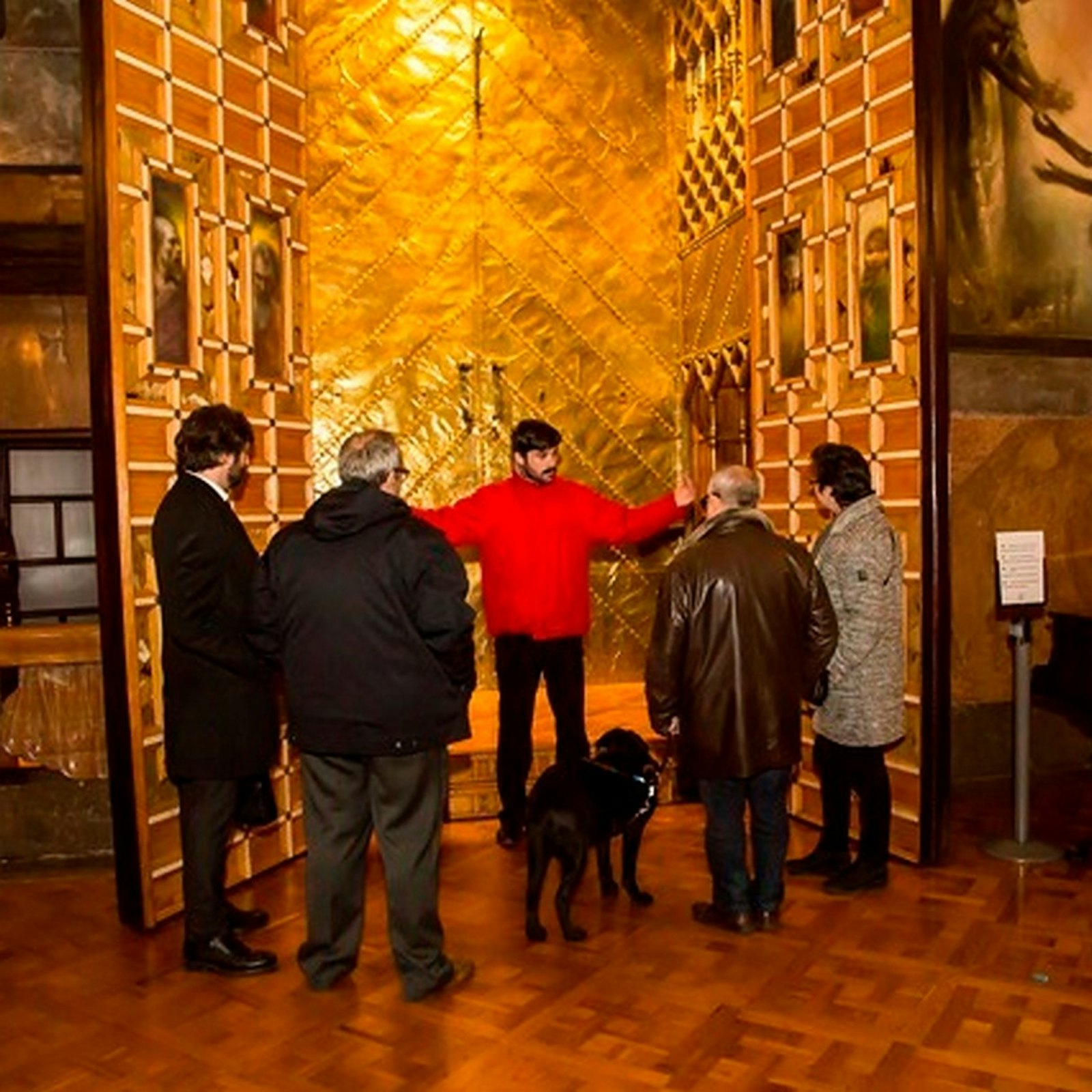Casa Milà La Pedrera + Palau Güell (Güell Palace): Combination Ticket
- Select your visit dates
- Completed secure payment
- Receive your tickets via email
Palau Güell (Güell Palace): Guided Tour
- Instant Ticket Delivery
- Smartphone Tickets Accepted
- Wheelchair Accessible
- Duration: 1 h
Palau Güell (Güell Palace): Entry Ticket
- Instant Ticket Delivery
- Smartphone Tickets Accepted
- Skip The Line Entry
- Wheelchair Accessible
- Audio Guide
Palau Güell (Güell Palace) Tickets and Information
- Palau Güell (Güell Palace) Address: 3-5 Carrer Nou de la Rambla, 08001, Barcelone
- Summer Opening Hours: Daily from 10:00 - 20:00 (Last Entry at 7PM)
Palau Güell (Güell Palace) Tickets
BESTSELLER
What's Included
- From: €12.00
- Skip-the-line admission to Palau Güell
- Access to all visitable areas of the building, including the rooftop
- Downloadable or physical audio guide in 13 languages (options: general, express, and kids)
About Palau Güell (Güell Palace)
Barcelona is a city known for many things and one of which is its rich architectural heritage. Home to multiple iconic landmarks that attract visitors from around the world and amongst them is Palau Güell (Güell Palace).
Llocated on Carrer Nou de la Rambla in the El Ravel neighbourhood of Barcelona, the magnificent palace was designed by the renowned architect Antoni Gaudí at the start of his career. A masterpiece that stands as a testament to his genius and his unique architectural style that helped to define Barcelona's landscape along with other landmarks in the city such as the Sagrada Familia, Casa Batlló & La Pedrera, also all being Gaudi's designs.
Palau Güell was one of Gaudi's first collaborations with Eusebi Güell (of Park Güell) and the two went on to be great friends and work together on other projects.
The property was designed as a residence for the Güell family as well as serving as a space for social and cultural events being hosted by the family and others. The building includes spaces such as a grand reception hall, a chapel, a main room for entertaining guests, and various living quarters and the stables located under the property.
What you see on a visit to Palau Güell (Güell Palace)
Visitors get to enjoy a closer look at the incredible UNESCO World Heritage Site.
Upon arrival, you can see from the outside it isn't a normal property. You are greeted by the intricate ironwork on the gates that welcome you and that's before you even enter the property.
Then once inside, the amazing contrast between light and dark space and how they actually compliment each other. Then there is the vibrant use of colours in various spaces. The way that Gaudi used natural light to fill the property and how it reacts with both the dark and light spaces.
If this is your first visit to a Gaudi property, it will unlikely be your last, but the start to the journey. If you've opted for a guided tour, your guide will point out the incredible features and give you a deeper understanding of the use and reason behind them.
As visitors wander through the interconnected rooms, each reveals a different facet of Gaudí's genius, from the lavish use of wood and stained glass to the symbolic elements seamlessly integrated into the architecture.
The 'pièce de résistance' is undoubtedly the central hall with its parabolic dome, a marvel of engineering and aesthetics.
Going up to the rooftop, visitors are treated to a forest of whimsically shaped chimneys and breath taking views of Barcelona.
Palau Güell is not just a building; it's a curated journey through time and artistic expression, something that Gaudi was known for in his designs, offering a glimpse into his mind and the opulence of Barcelona's architectural heritage.
Palau Güell (Güell Palace) Fun Facts
- Eusebi Güell (who commissioned the property) is also the same person that owned Park Güell.
- Palau Güell is also listed by UNESCO as part of the 'Works of Antoni Gaudi' collection.
- The entrance gate on the property is particularly impressive and noteworthy.
- The chimneys resemble medieval warriors (a feature Gaudi also used on other properties).
- The property also contains underground horse stables.
- Like many of Gaudi's other properties, you won't find many straight lines at Palau Güell due to Gaudi's love of nature.
History of Palau Güell
Early Origins and Eusebi Güell's Vision
Palau Güell's history finds its roots in the late 19th century when the wealthy industrialist Eusebi Güell (of Park Güell) commissioned Antoni Gaudí to design a residence reflecting his social status.
The project was started in 1886 and completed in 1888 and marked the beginning of a collaboration between the two that would result in one of Barcelona's most extraordinary architectural achievements and started a friendship between the two that would last their lifetimes and involved further projects.
The location chosen for this grand project was in the heart of the city's old town and a testament to Güell's desire to create a palatial residence that would be both opulent and strategically situated.
Architectural Evolution: Gaudí's Creative Genius
Antoni Gaudí, often hailed as the father of Catalan Modernism, infused Palau Güell with his distinctive architectural style and Gaudi's influence is clear on the property. The construction ended up spanning ten years, from 1886 to 1896 and then with subsequent modifications continuing until 1906 when this Gaudi masterpiece would finally be complete.
The palace, though initially designed as a residence, eventually became a focal point for artistic expression and cultural gatherings.
Decline and Restoration: Rescuing a Cultural Gem
As the 20th century progressed, Palau Güell faced neglect and deterioration. In the latter part of the century, efforts were made to restore this architectural gem to its former glory. The restoration process was initiated in the 1980s and aimed not only to preserve the physical structure but also to showcase the historical and artistic significance embedded in its walls. Today, Palau Güell stands as a meticulously preserved time capsule, allowing visitors to step back in time and enjoy and witness the grandeur of a bygone era as well as being another incredible Gaudi property open to the public with the appropriate ticket. Palau Güell was also given UNESCO World Heritage Site in November of 1984.
Architectural Style of Palau Güell
Palau Güell serves as a perfect example of Catalan Modernism, an architectural movement that emerged in the late 19th and early 20th centuries as a response to the industrialization sweeping through Europe and something that Antoni Gaudi used in his work. This architectural style sought to blend tradition with innovation, incorporating modern techniques while staying rooted in regional identity. The style can be seen in various Barcelona landmarks and historical sites, especially some of those designed by Gaudi.
Unique Features: Gaudí's Artistic Expression
One of the distinctive features of Palau Güell and its architecture is its innovative use of space and light. Gaudí was known for his love of organic designs that were inspired by nature and which created a seamless integration of form and function. The palace's façade is adorned with intricate ironwork, another hallmark of Gaudí's style. The interior boasts a series of interconnected rooms designed to facilitate the flow of light and air and for functionality, which was also incredibly important to Gaudi.
Symbolism in Design: Telling Stories Through Architecture
Gaudí's architectural creations are often designed with symbolism, and Palau Güell is no exception. The use of motifs from nature, religious symbolism, and the incorporation of the owner's family symbols are evident throughout the palace. The chimneys on the rooftop, for instance, are sculpted into fantastical shapes, resembling warriors and knights. Gaudi is known for using symbolism throughout multiple projects.
Visitor Experience
Guided Tours: Unveiling the Secrets of Palau Güell
To fully appreciate the magnificence of Palau Güell, we would suggest you enjoy a guided tours. The knowledgeable guides provide insights into the historical context, the architectural nuances, and the life of Antoni Gaudí which gives you a deeper understanding of the property and its also likely they will point our features that you may not notice is exploring by yourself.
Visitors can explore the various rooms, each uniquely designed, and learn about the purpose behind every element. The rooftop, with its intricate chimneys and its amazing panoramic views of Barcelona, is a highlight of the tour and offers a glimpse into Gaudí's visionary approach to architecture.
Cultural Events: Palau Güell as a Living Venue
Beyond its role as a tourist attraction, Palau Güell continues to serve as a cultural venue. The palace hosts various events throughout the year, including concerts, exhibitions, and lectures which all add a contemporary layer to its historical significance. This dynamic use of space aligns with Gaudí's vision of architecture as a living, evolving entity that engages with the community and which is why one of his chief design goals was to make his designs practical and functional spaces.
Preservation and Future
UNESCO World Heritage Site: Safeguarding a Global Treasure
In 1984, Palau Güell proudly earned the distinction of being designated a UNESCO World Heritage Site. A recognition that underscores the global importance of Gaudí's work along with the cultural significance embedded in Palau Güell's walls.
The UNESCO designation also emphasizes the responsibility of preserving and maintaining this architectural treasure for future generations to enjoy, not just as a Gaudi design but as an example of how things used to be.
Ongoing Conservation Efforts: Balancing Preservation and Accessibility
The preservation of Palau Güell requires a delicate balance between conservation and accessibility. Ongoing efforts focus on maintaining the structural integrity of the building along with restoring damaged elements, and implementing measures to protect it from environmental factors. The goal is to ensure that Palau Güell remains a living testament to Gaudí's genius, an incredible example of Barcelona historical sites and to continue to inspire awe for centuries to come.
Palau Güell stands as a testament to the creative genius of Antoni Gaudí and the enduring allure of Barcelona's architectural landscape. From its inception in the late 19th century to its current status as a UNESCO World Heritage Site, the palace has weathered the passage of time with grace. Visitors to Palau Güell are not merely spectators but participants in a journey through history, culture, and the boundless imagination of one of the world and that is why it remains as one of Barcelona's best selling tourist attractions and landmarks.
Useful Information About Palau Güell (Güell Palace)
How to get there
Palau Güell (Güell Palace), 3-5 Carrer Nou de la Rambla, 08001, Barcelona
- Metro: Liceu, line 3
- Buses: V13, 59, 91, 120 and Barcelona Bus Turistic
- FGC: L6, L7, S1, S2, S5, S55
Opening Hours
Summer Opening Hours (1st April - 30th September):
- 10:00 AM - 20:00 PM
Winter Opening Hours (1st October - 31st March)
- 10:00 AM - 17:30 PM
Closed:
- Mondays (except public holidays), 25th December & 26th December, 1st January and last week of January
Palau Güell
More TicketsPalau Güell (Güell Palace) Tickets
Frequently asked questions
No, Palau Güell isn't located inside Park Güell. They share the same name as the same person (Eusebi Güell) owned both!
That is correct! Palau Güell and Park Güell were both owned by the local industrialist and businessman Eusebi Güell! He and Antoni Gaudi were great friends.
it certainly is! Palau Güell was proudly listed by UNESCO World Heritage back in 1984!
We love the guided tours as the guide will give you a deeper insight into the property, however it isn't compulsory. You can still enjoy a visit without a guide. You also get an audio guide with your ticket which will provide you with some information.
We don't think so no. Gaudi was very clever, so even though there are dark areas, they way he uses natural light - lights those areas. The property isn't scary at all. Its amazing!
Yes - Palau Güell is wheelchair accessible, however some wheelchairs may have difficulty in the elevator. Where that is the case, Palau Güell do offer a special wheelchair.









